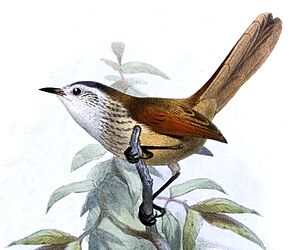Necklaced spinetail facts for kids
Quick facts for kids Necklaced spinetail |
|
|---|---|
 |
|
| Conservation status | |
| Scientific classification | |
| Genus: |
Synallaxis
|
| Species: |
stictothorax
|
 |
|
The necklaced spinetail (Synallaxis stictothorax) is a small bird. It belongs to the ovenbird family, which is called Furnariidae. You can find this bird in Ecuador and Peru.
Contents
About the Necklaced Spinetail
The necklaced spinetail has two main types, called subspecies. These are S. s. stictothorax and S. s. maculata. For a long time, another bird, the Chinchipe spinetail, was thought to be a third type of necklaced spinetail.
However, scientists studied these birds more closely. They looked at how they looked, the sounds they made, and their family tree. Based on this new information, experts decided in 2021 that the Chinchipe spinetail is actually its own separate species.
What Does It Look Like?
The necklaced spinetail is a small bird, about 11 to 13 cm long. It weighs between 10 and 14 grams. Both male and female birds look very similar.
They have a white stripe above their eyes, called a supercilium. Their face is mostly blackish with some faint white lines. The front part of their head has black and white stripes. The rest of their head is dull grayish-brown.
Their back is brownish, and their rump is a reddish-brown color. The feathers covering their upper tail are bright reddish. Their wings have some white near the bend. The main wing feathers are reddish, while the outer ones are dusky (dark).
Their tail is bright reddish, except for the two middle feathers, which are dark brownish. Their throat is white, and their chest is a buffy white with thin black stripes. Their belly is whitish, and their sides are a yellowish-brown.
Their eyes can be brown or reddish-brown. Their beak is black, sometimes with gray on the lower part. Their legs and feet are blue-gray to dark gray. Young birds' feathers have not been described yet.
The subspecies S. s. maculata has a slightly more reddish back. It also has more reddish color on its wings than the other subspecies. Its tail is reddish, with only a small amount of dark color on the very inner feathers.
Where It Lives
The necklaced spinetail lives in two separate areas. The S. s. stictothorax subspecies is found in southwestern Ecuador. This includes areas from central Manabí Province south to western Guayas Province and Puná Island.
The S. s. maculata subspecies lives from southern Loja Province in Ecuador down into northwestern Peru. It can be found as far south as the Department of La Libertad in Peru.
These birds like to live in dry scrublands. They also live at the edges of forests where trees lose their leaves. In Ecuador, they live from sea level up to about 300 meters high. In Peru, they can be found up to 400 meters high.
Behavior and Habits
Movement
The necklaced spinetail stays in the same area all year round. It does not migrate.
What It Eats
This bird eats arthropods, which are small creatures like insects and spiders. It is quite active and bold when it looks for food. It is also more acrobatic than many other birds in its group.
Necklaced spinetails usually search for food in pairs. They often join groups of different bird species that are feeding together. They pick their prey from moss, leaves (both living and dead), and small branches. They usually feed close to the ground, about 1 or 2 meters high.
Reproduction and Life Cycle
Scientists haven't fully figured out the necklaced spinetail's breeding season. However, active nests have been found in February and March.
Their nest is shaped like a ball and made of sticks. It has an entrance on the side. Inside, the nest is lined with soft feathers and plant down. They usually build their nests in thorny trees or cacti. These nests can be up to 12 meters above the ground.
A female bird usually lays three to four eggs. The eggs hatch after about 25 days. The young birds leave the nest when they are 16 to 22 days old. We don't know much about how the parents care for their young.
Sounds It Makes
The main song of the necklaced spinetail is a short, chattering sound. It ends with several squeaky, strong notes. It sounds like "trrr-tr-tr-kweet...kweet".
Pairs of birds often sing together, especially in the early morning and late afternoon. They usually sing from deep inside thick plants. Sometimes, they will sing from a spot where you can see them.
Their calls include a long, rattling series of notes. This sound can change in speed and pitch. They also make a nasal, rising "weet" sound or a slightly two-part "kweet". Another call they make is a squeaky "di'vot".
Status and Conservation
The IUCN (International Union for Conservation of Nature) has listed the necklaced spinetail as a species of "Least Concern". This means they are not currently worried about it becoming endangered.
The bird lives across a fairly large area. Its total population size is not known, but experts believe it is stable. There are no immediate threats that scientists have found.
The necklaced spinetail is considered quite common. It also lives in several protected areas. It can even handle some changes to its habitat, like moderate damage to its environment.



